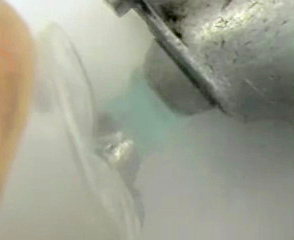Paramagnetism facts for kids

Paramagnetism is a special kind of magnetism. It happens when certain materials are slightly pulled towards a magnetic field. When a magnet is brought close, these materials create their own small magnetic fields. These new fields point in the same direction as the main magnetic field. Many common elements and some compounds are paramagnetic.
Contents
What is Paramagnetism?
Imagine you have a strong magnet. If you bring a paramagnetic material close to it, the material will be gently attracted. This attraction is usually quite weak. It's not like a strong magnet sticking to a fridge. Instead, it's a subtle pull.
Inside every atom, tiny particles called electrons are always moving. This movement creates very small magnetic fields. In most materials, these tiny magnetic fields point in random directions. They cancel each other out, so the material doesn't act like a magnet.
How Paramagnetism Works
Paramagnetic materials are different because they have some electrons that are "unpaired." Think of electrons as having a tiny spin, like a spinning top. Each spin creates a tiny magnetic moment. In most atoms, electrons pair up with another electron spinning in the opposite direction. These pairs cancel out each other's magnetic effects.
However, in paramagnetic materials, there are some electrons that don't have a partner. These "unpaired" electrons mean the atom has a small, permanent magnetic moment. These tiny magnets usually point in random directions, so the material isn't magnetic on its own.
When an outside magnetic field is applied, these tiny magnetic moments of the unpaired electrons try to line up with the field. This lining up is what causes the weak attraction. The stronger the outside magnetic field, the more these tiny magnets line up.
Examples of Paramagnetic Materials
Many common substances are paramagnetic. Here are a few examples:
- Oxygen: The air we breathe contains oxygen, which is paramagnetic. If you cool oxygen down enough, it becomes a liquid. You can then see liquid oxygen being held between the poles of a strong magnet, as shown in the picture.
- Aluminum: This metal is used in many everyday items, like soda cans. It is also paramagnetic.
- Titanium: A strong, lightweight metal used in airplanes and sports equipment.
- Many elements: Most chemical elements on the Periodic table that have an odd number of electrons are paramagnetic. This includes elements like sodium, potassium, and copper.
- Some salts: Certain salts, like iron chloride, also show paramagnetic properties.
Paramagnetism vs. Other Types of Magnetism
It's helpful to understand how paramagnetism compares to other types of magnetism:
- Ferromagnetism: This is the strong magnetism you usually think of, like with iron magnets. Ferromagnetic materials can become permanent magnets. Their magnetic moments line up very strongly and stay aligned even after the outside field is removed.
- Diamagnetism: Most materials are diamagnetic. They are very weakly repelled by a magnetic field. This happens because the magnetic field slightly changes the motion of all electrons, creating a tiny opposing magnetic field. Water, wood, and plastic are examples of diamagnetic materials.
Paramagnetism is in between these two. It's a weak attraction, unlike ferromagnetism, and it's an attraction, unlike diamagnetism.
Images for kids
See also
 In Spanish: Paramagnetismo para niños
In Spanish: Paramagnetismo para niños



